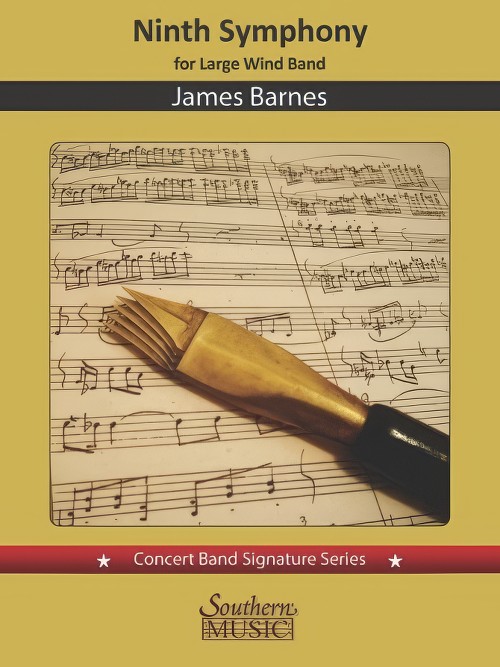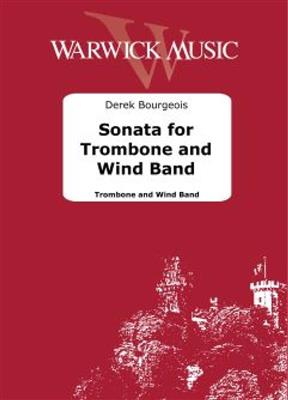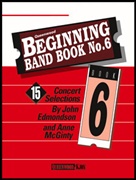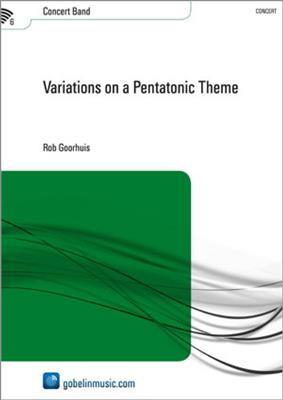Results
-
 £309.99
£309.99Ninth Symphony (Concert Band - Score and Parts) - Barnes, James
Premiered on 21 September, 2018 in Lawrence, Kansas by The University of Kansas Wind Ensemble (Dr. Paul Popiel, conducting), James Barnes' Ninth Symphony was composed between January and late June of that same year. This large work was commissioned by a consortium of twenty-one college bands, community bands, professional bands and individuals to help mark the 70th birthday of the composer (b. 1949). It is an expansive forty-minute work in four movements, of which the composer writes, "This is my last symphony...this work represents a compendium of all that I have learned during the fifty years of composing and scoring for this wonderful new medium: the modern wind band." The first movement, subtitled Elegy, is based around G minor. It is the longest movement of the symphony. Tragic and despondent in character, it is cast in sonata-allegro form. The second movement is entitled Scherzo. Barnes claims that "I have always wanted to write a waltz," and that is how this movement is cast, in a modified rondo form in D minor. In contrast to the mood of the first movement, the scherzo is a delightful posy of expansive melody, splashy color, humor and rhythm. The third movement, which is in a modified tertiary form, is entitled Night Music. In contrast to the scherzo, this movement begins with a mysterious incantation, first displayed by solo Alto Flute. The music becomes even darker and more mysterious, while overall the movement effectively expresses an "otherworldly" mood, ending with a solo soprano offstage which suddenly emerges, eerily singing a modified version of the opening incantation. Cast in sonata-allegro form, the fourth movement is most definitely a rousing Finale, beginning with a brilliant fanfare and undergoing several mood transformations before emerging into the final coda, ending the symphony with an energetic splash of color. Duration: 40.00
Estimated dispatch 7-14 working days
-
 £75.00
£75.00Sonata - Derek Bourgeois
This work, composed in 1998, was commissioned by the American trombonist Don Lucas as a work for trombone and piano and first performed by him in Birmingham on 19th May 2000. Subsequently, I arranged the music for both solo trombone and brass band and solo trombone and wind band so that it now exists in three formats. The first movement, in B flat major, is brisk and energetic, and is cast in sonata form. The second subject is gentler and more lyrical. The second movement, a scherzo in C major, is the most complex of the four. Basically the structure is a rond. For a long time the music remains in the opening 5/8 time until a new theme introduces more broken rhythms in a more jazzy idiom. After a return of the opening theme the following episode is more tonally ambiguous. Finally, the main theme returns to round off the movement. The third movement, a lyrical adagio, is really one long extended melodic flow. The harmonies are lush and the textures simple and direct. The tonal center is A minor, but the music meanders through so many keys, that this key centre is heavily disguised. The finale is a fiery affair. G minor is really its home key, but throughout the movement the music moves about a lot and the second subject is first heard in A flat minor. The movement's underlying sonata structure is masked not only by its loose tonality but also by its frequently changing time signatures. Like the first movement the second subject is more lyrical in nature and for a while it seems that the music will end peacefully, but a final flurry heralds a triple forte unison on the home note of the first movement - B flat. Derek Bourgeois
Estimated dispatch 7-14 working days
-
 £79.99
£79.99Nexus - James Curnow
The word nexus is defined as a tie or link between people and events. Nexus for solo trumpet and band includes several links between composer James Curnow and educator Alfred Watkins, to whom the work is dedicated. A well-knowntheme (particularly to Mr. Watkins' students) is drawn upon as the piece utilizes two primary musical settings - an energetic and agile scherzo that appears in the beginning and again at the end, contrasted with an expressiveballad theme. The soloist at the premiere (and on the recording) is Christopher Watkins, Alfred's son. This is a well-crafted and rewarding work for soloist and band alike. Dur: 6:00 (Recorded by the University of Alabama atBirmingham Wind Symphony - Dr. Sue Samuels, conductor. Christopher Watkins, trumpet soloist.) Also available for trumpet with piano reduction - HL00231702.
Estimated dispatch 7-14 working days
-
 £30.00
£30.00BEGINNING BAND BOOK No.6 (Score inc. CD) - Edmondson & McGinty
An affordable collection of concert repertoire for beginning bands; great sight reading material for more advanced bands! Features include: Grade 1 concert band music; Playable with only 1 flute, 2 clarinets, 1 alto saxophone, 2 cornets/trumpets and percussion, up to full instrumentation; Full, complete sound, even without bass clef instruments. The bass clef part in octaves is optional; Both clarinet parts stay below the break; Optional F Horn and Tenor Saxophone parts are written in their best ranges; Bell part for teaching melodic percussion. Contents: Bells, Bells, Bells; Command Z; Fire Dance; The Funky Turtle; In the Zone; Introduction and Scherzo; Japanese Folk Trilogy; Kum Ba Yah; Morningstar Overture; Mount Vernon March; Multiple Choice; Ramsgate Festival; Stratford Fair; Superstition Overture; Those Clever Clarinets.
Estimated dispatch 7-14 working days
-
£13.95
Chivalry
1Forgotten Heroes - Concert MarchNigel ClarkeRoyal Northern College of Music Wind Orchestra9.062-5In the Realm of the Sun GodKit TurnbullRoyal Northern College of Music Wind Orchestra I. At Dead of Night 1.32 II. The Ascension of the Sun God 3.06 III. Rite of Sacrifice 3.18 IV. The Rebirth of the Sun God 1.496-10Tales from AndersenMartin EllerbyRoyal Northern College of Music Wind Orchestra I. Overture - The Steadfast Tin Soldier 1.58 II. Soliloquy - The Little Match Girl 2.08 III. Scherzo - The Emperor's New Clothes 1.16 IV. Idyll - The Snow Queen 1.42 V. Finale and Chorale - The Red Shoes 2.2211-14Partita for Concert BandDarrol BarryRoyal Northern College of Music Wind Orchestra I. Introit 4.07 II. Impromptu 2.23 III. Elegy (31/12/04) 4.53 IV. Finale 4.1415-17Three Paintings by LautrecLaurie JohnsonRoyal Northern College of Music Wind Orchestra I. At the Circus - The Equestrian 2.27 II. The Girld with Red Hair 2.46 III. Chocolat - Dancing 2.1018Chivalry - Symphonic Tone Poem for Brass, Wind and PercussionMartin EllerbyRoyal Northern College of Music Wind Orchestra14.0519Skyrider - Concert MarchPhilip SparkeRoyal Northern College of Music Wind Orchestra3.40
Estimated dispatch 7-14 working days
-
 £84.99
£84.99A Copland Portrait - David Conte
Originally commissioned by maestro Neal Gittleman, A Copland Portrait was premiered by the Dayton Philharmonic Orchestra in January 2000. In March of 2015, First Lieutenant Ryan Nowlin's transcription of this work for band was premiered by "The President's Own" United States Marine Band under the direction of Lieutenant Colonel Jason Fettig. ECS Publishing is proud to offer both the band and the orchestra version. Conte on the creation of this overture: "I set out quite consciously to evoke various aspects of Copland's work by combining and recombining them within the terms of my own musical personality. For example, the first theme of A Copland Portrait combines the character of a theme from The Red Pony with the rhythmic texture of the scherzo of the Third Symphony. While composing the piece I was conscious of drawing inspiration from many of Copland's works; a melodic shape here, a harmonic gesture there, until I arrived at something that felt fresh and new to me. A Copland Portrait is cast in a traditional Sonata-Allegro form. After a vigorous, syncopated orchestral tutti, the first theme is announced in the solo oboe, accompanied by a steady eighth-note ostinato. Playful interjections are stated in the flute and bassoon. The syncopated tutti returns; the first theme is stated again, this time in the low winds. This theme builds to a colorful climax, leading into a more dissonant transition section, which gradually slows and gives way to a lilting, more lyrical second theme in the clarinet. After some modest development of the second theme, a more plaintive theme stated in the muted trumpet brings the exposition to a close. A scherzando development section follows; the first four notes of the first theme are inverted and subjected to various contrapuntal treatments. This development section ends with a return of the opening syncopated motive, leading into a recapitulation of the first theme, this time in canon, and the second theme and closing theme, broadly sung. A brilliant toccata-style coda brings A Copland Portrait to a brisk conclusion."
Estimated dispatch 7-14 working days
-
 £145.50
£145.50Afternoon Games - Eric Ewazen
OLD SETTLERS' PICNIC is a is a four-movement suite for Band by Eric Ewazen, arranged by Virginia Allen; each movement is published separately. Composed with high school performers in mind, the suite was inspired by an 1890s photograph and descriptions of a Wisconsin town's "Old Settlers" celebration. AFTERNOON GAMES are depicted with a Vivace scherzo in 6/8. The running and skipping leads to an extended fugue for a copycat game before returning to the opening theme.
Estimated dispatch 7-14 working days
-
 £274.99
£274.99Symphony No. 2: States Of Mind, Opus 87 - Teo Aparicio-Barberán
I- Logos (reason)II- Pathos (emotion)III- Ethos (credibility)The ancient Greeks believed that music shaped the character of man. In Egyptian temples, music was an essential part of the magical rites to alter the course of nature or to treat illness.And today we know that sound can actually alter matter. The secret of music lies in harmony and mathematics, as many great musicians and experts have always known.One of the most important qualities of music is that it enables the listener to focushis attention inwards instead of on what is around him. It is indisputable that music can inspire emotion. Music leads us into a universe of emotions that are difficult to put into words. In short, music reaches into corners of our soul and thoughtsthat words cannot reach and makes it possible to more clearly describe these different States of mind.The composer of this symphony also believes that each "musical argument" must be constructed so that it will induce the desired reaction in thelistener.Music: more than wordsIn recent times, most orchestral symphonies have been based on a story, a text or something similar so that their composition must be structured accordingly.The intention of this work by Teo Aparicio-Barbern is quitedifferent. The composer describes the three elements of the argument as the only formal structure of the work. Since certain philosophers in world history were able to subdivide grammatical argument, why shouldnt that also be possible for the musicalargument?Since ancient times the power of the spoken word has captivated mankind. How can an argument move people and mobilise the masses? Where does the power of words come from today? The answer lays not so much in what people say but in how theysay it.Rhetoric is one of the oldest humanist disciplines in Western civilisation. Aristotle, in the 4th century BC, called it the art of persuasion. Indeed, the terms rhetoric and persuasion are mutually interchangeable.More than 2000 years agoAristotle structured his rhetoric according to the following three elements: the logos, the pathos and the ethos.Logos (words, reason) is the reasoning that gives freedom to the structure of the text by expressing what one wishes to say usingspecialist terms. With logos we create arguments to receive public approval and to defend our ideas.Pathos, the second element, refers to the effective use of public psychology. Pathos can be considered as the capacity to induce the desired emotionalresponse in the public, by creating an emotional connection with the public so that they accept our message.The third element, ethos (credibility), refers to the character of the speaker and is perhaps the most important of the three elements.Aristotle based his concept of ethos upon his belief that truth and justice will always have the upper hand over anger. He believed that what was true and good was easier to prove and was more persuasive.This second orchestral symphony from thecomposer from Enguera follows these three parameters of the argument according to Aristotle. Each movement tries to summon a different state of mind in the listener so that the message itself can be better understood and appreciated. Apart from thesethree general concepts the music is only structured, as Claude Debussy would say, in a "formative way".The first movement, logos, is based on a scherzo melody that undergoes various changes in rhythm and harmony. The arguments are presented by meansof conventional techniques of composition. The second movement, pathos, is characterised by suggestions of sound. It is subdivided into two large parts. The first part is based on a five seven sequence with five sounds that are repeated in differentenvironments, structures and dynamics. The second part, which is largely tonal, brings out more directly the emotional overtones that each argument must have. The third movement, ethos, is a faithful rendition of the composers personality. In thislast part, clear rhythmic sequences stand out, there are large dynamic contrasts and lots of tone variation. In addition, and this is quite in keeping with the composers earlier work, the harmony in States of Mind is handled in a manner that is bothoriginal and efficient, as a result of which Aparicio-Barberns message is well understood by the listener.This second symphony by Teo Aparicio-Barbern is devoted to "my dear Henrie Adams, a guiding light in this eternally dark musical world. Thankyou for everything."
Estimated dispatch 7-14 working days
-
 £244.99
£244.99Variations on a Pentatonic Theme - Rob Goorhuis
Rob Goorhuis wrote his Variations on a Pentatonic Theme (1987) for the Royal Wind band of Thorn, conductor Jan Cober. The work consists of five character variations on a pentatonic (five-tone) theme. The basic elements of the theme are the descending minor third and the descending major second, which in the course of the composition build up to a broad melody, unfolding itself in the final variation. The first variation resembles minimal music in its repetitive rhythmic motives. The second variation is explosive in character: rapid broken chords provide a background for soft solo motifs. The third variation is a quiet intermezzo on a slow chorale theme, creatingtwo contrasting moods. The fourth variation is a light-hearted scherzo. The final variation is a brilliant finale with all the necessary ingredients, or, in the composer's words, "the works" Testpiece WMC 2005 Concert Division.
Estimated dispatch 7-14 working days
-
 £168.50
£168.50Manhattan - Philip Sparke
Version for Concert BandManhattan was commissioned by the United States Army Band for their solo cornet player Woodrow English and first performed by them in Carnegie Hall, New York, in November 2003. The two-movement work demonstrates both the lyrical and technical abilities of this outstanding player. The 'theme' is a weekend in New York and the opening bluesy movement, Saturday Serenade, describes the city on a Saturday night. While writing the second movement, Sunday Scherzo, the composer pictured an early morning jog in Central Park. This vivaciously rhythmic second movement ends with an even quicker coda bringing the work to a brilliant close. Eachmovement can also be played individually when a shorter solo is required.
Estimated dispatch 7-14 working days
